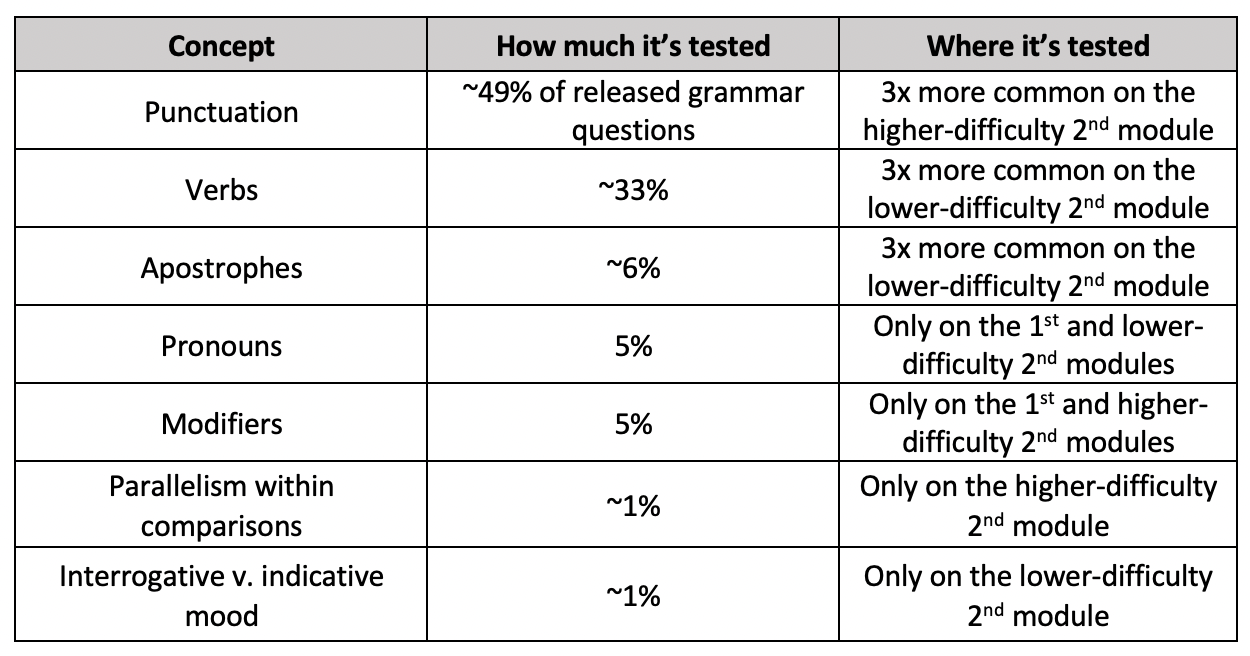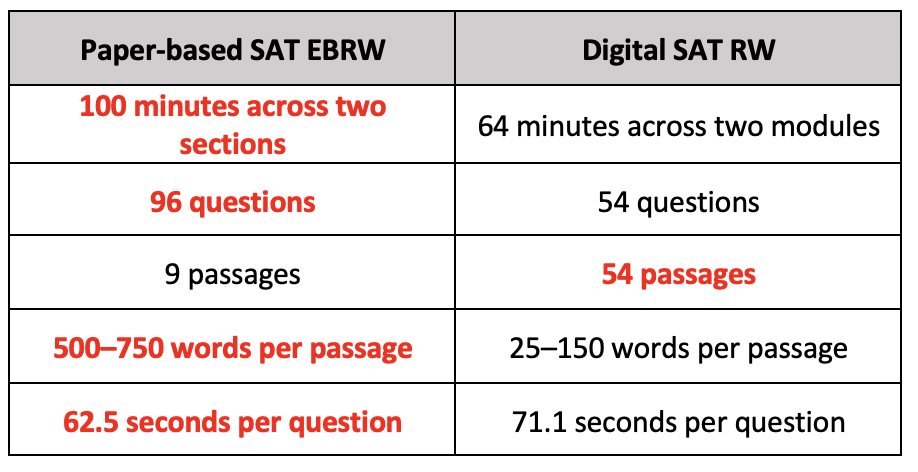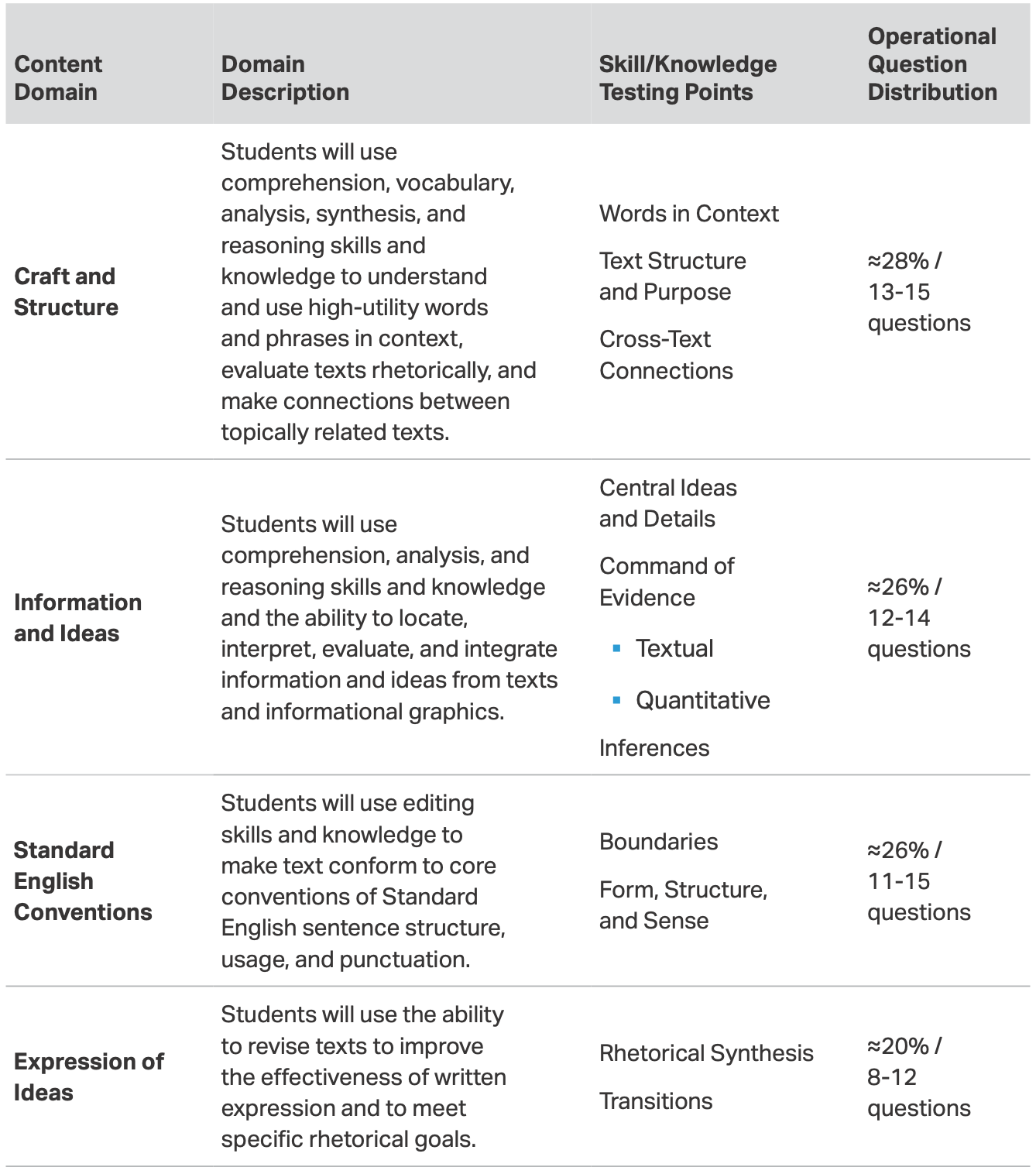Updated June 2023
In October 2022, the College Board released the new digital SAT’s first practice tests—and our curriculum team immediately sank their teeth into these, taking each test hundreds of times to map every question type and adaptive module. We’ve already taken a bird’s eye view of what these tests can teach us about the digital SAT’s overall design.
In this post, we’ll get more concrete: We’ll look at exactly how the Reading and Writing (RW) modules have changed from the paper test’s equivalent sections. And in case you’re a student, we’ll also round up some of our initial tips for how you can prepare.
The short version? The digital SAT’s RW modules feel (and are) very different from the paper SAT.
Question composition has changed; your prep will also change
SAT prep books are about to get a bit shorter. While most digital-SAT question types have their analogues on the paper test, several old question types and concepts have been cut. The following are frequently tested by the paper SAT but are NOT tested by the digital exam:
- homophones
- idioms and frequently confused vocabulary (ex: effect v. affect)
- historical documents
- redundancy and concision
- sentence placement
- pronoun ambiguity
- parallelism within lists
- combining sentences
- paired questions that ask you to answer a question about the passage and identify supporting textual evidence
- questions with two-part answers that ask whether the author should keep or delete a sentence, or whether or not they should add a sentence
With so many omissions, the new test-taking experience feels a lot more streamlined. To get the highest score you can, you’ll still need to prep in advance, but there will be fewer strategies you need to learn and fewer rules to memorize. Speaking of rules…
Grammar is a bit more streamlined, too
Of the 324 new RW test questions we’ve catalogued from the new practice tests, 80 test grammar. Setting aside what isn’t tested, here’s a breakdown of the grammatical concepts that the Digital SAT does test:

All of the above comes with a big caveat—the digital SAT is still new, and four practice exams isn’t yet a large enough sample size for us to confidently say just how frequently the actual exam will or won’t test these concepts. Still, this breakdown at least strongly hints at how significant different concepts are (and aren’t) on the new test.
To improve your RW score, you’ll have to first learn the rules governing punctuation and verbs, since these comprise the vast majority of grammar questions. Once you’ve mastered those, you can inch your score closer to perfect by covering the more esoteric concepts like modifiers, parallelism, and mood. Need a study plan or resources to learn all these rules? Reach out to us here. But the differences in these sections go beyond these sorts of nitty-gritty little changes…
New passage types, new organization, a different type of endurance
Let’s zoom out for a minute to look at the raw numbers for both versions of the test, highlighting in red the “scarier” data points:

The contrast is obvious: The new test looks more manageable in almost every way. On the paper-based test, the Evidence-Based Reading section is especially notorious for taxing students’ test-taking endurance and focus through long passages with 10–11 questions each. But even though the digital SAT is shorter, it still tests your endurance—it’s just a different type of endurance.
The digital SAT has 6 times as many passages to read. Because there’s a different passage with every question, you will need to continually reset, setting aside the context from the previous question and reorienting yourself in the new passage. For some, this new format might very well play to their strengths as readers; for others, the huge increase in number of passages will come with its own variety of mental fatigue.
There’s also a noticeable shift in the types of passages. The infamously tricky-to-parse historical passages are gone, there’s now just a single question per test that asks you to compare two passages, and there is a greater variety of literary genres represented—including poetry, personal essays, and plays, all of which are at least 100 years old.
Arguably the biggest shift, though, is how questions are organized. On these sections of the paper-based test, multiple question types of unpredictably varying difficulty level are all mixed together; on the digital test’s RW section, questions are grouped together first by type, then by difficulty level. At the end of the day, this all adds up to a much more predictable section. Here’s the College Board's official list of question types (note: Operational Question Distribution is listed by test, not by module):

So, for instance, rather than questions on transitions being spread throughout the section, you might encounter up to 4 of them in a row, then no others for the rest of the module. And you’ll always find transition questions in the same place—after 5-to-8 grammar questions and before 0-to-6 rhetorical synthesis questions.
All of these changes, inevitably, present strategic opportunities for the savvy test-taker.
A new test means new strategies
As test prep experts, we know that as long as the SAT’s content and/or structure are at least somewhat predictable, students will be able to strategically "game" it.
Here’re a few quick strategies to help you through this section of the digital SAT.
Strategy 1: Use the question prompt to narrow your focus
Because each passage is paired with just a single question, a large percentage of the details in a passage may be irrelevant. To avoid wasting time and brainpower, whenever you come to a new question, don’t dive straight into the passage; instead, read the question first and summarize its goal, so you know what to look for. Then, as you read the passage, you can filter out all that extra junk and pinpoint just what you need to answer the question.
Strategy 2: Reorder the questions, vegetables-first or dessert-first
Depending on your strengths and weaknesses as a test taker, some question types are going to be harder than others, requiring more time, more focus, or just more double-checking. Because questions now have a predictable order, you can take one of two routes to make the test-taking experience a bit more manageable.
You can take the vegetables-first route: complete the hardest, most attention-consuming questions first. This is a good match for students who find that they start the test strong, perhaps thanks to a big boost of adrenaline, but then have a harder and harder time focusing as the test goes on. If, for instance, one of these students finds a question about the nuances of an author’s argument to be fairly demanding, but they’re able to breeze through any vocab question, they might choose to skip the module’s first several questions, going straight to the Information and Ideas questions.
Or you can take the dessert-first route: get all the easy stuff out of the way first. This is a good match for students who get a few jitters at the start of a test module, but who do better when they’re able to first warm up with a few softball questions.
Strategy 3: Identify the question type, then use the right approach
As you come to a test question, identify what skill the question is testing, then use the relevant question-type-specific approach. We’ve previously covered a number of the approaches you’ll need for the RW section’s different question types:
Is it a vocabulary question? Look for clues in the passage that help you predict an answer.
Is it a transition question? Read the full context and identify how the pieces of information relate.
Is it the new rhetorical synthesis question type, in which you’re given a bulleted list of information and asked to synthesize it for a particular purpose? You don’t even need to read the bulleted information.
Need more individualized advice?
The recommendations above are general suggestions. If you have specific questions, reach out to our experts here. We’re happy to help in any way we can.
About ArborBridge
ArborBridge is the global leader in innovative, digital, one-on-one tutoring. With nearly a decade of experience teaching students online, ArborBridge supports students of all kinds: home schoolers, AP students, test preppers, and more. Our tutors specialize in creating personalized plans and in providing compassionate support for students and families.






